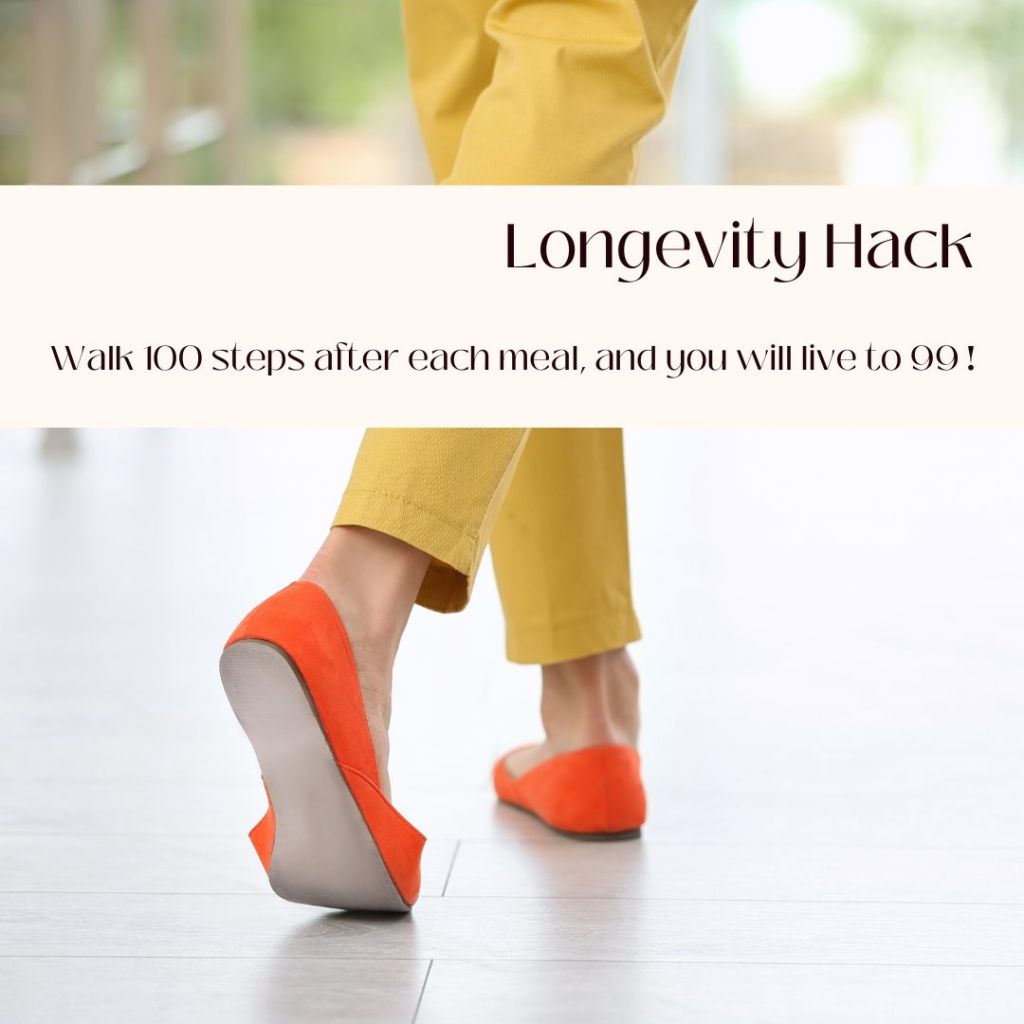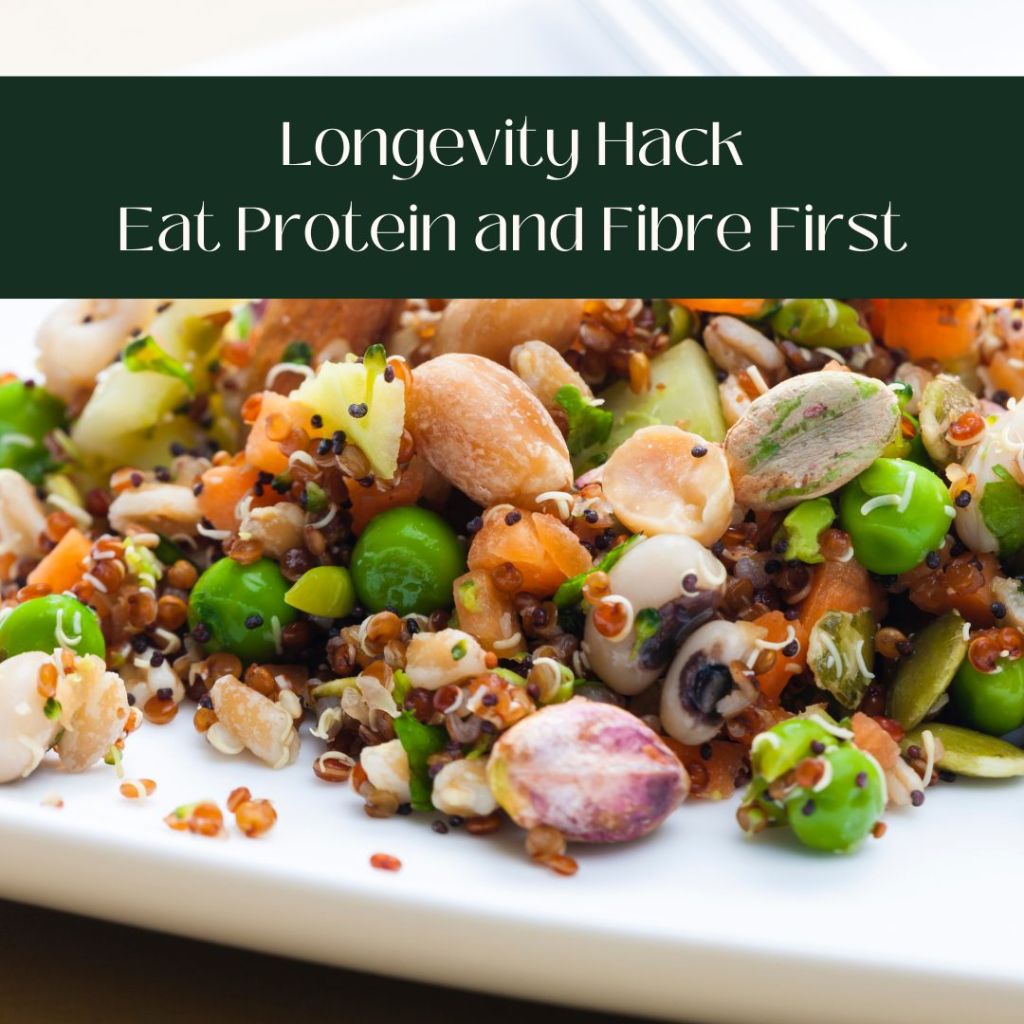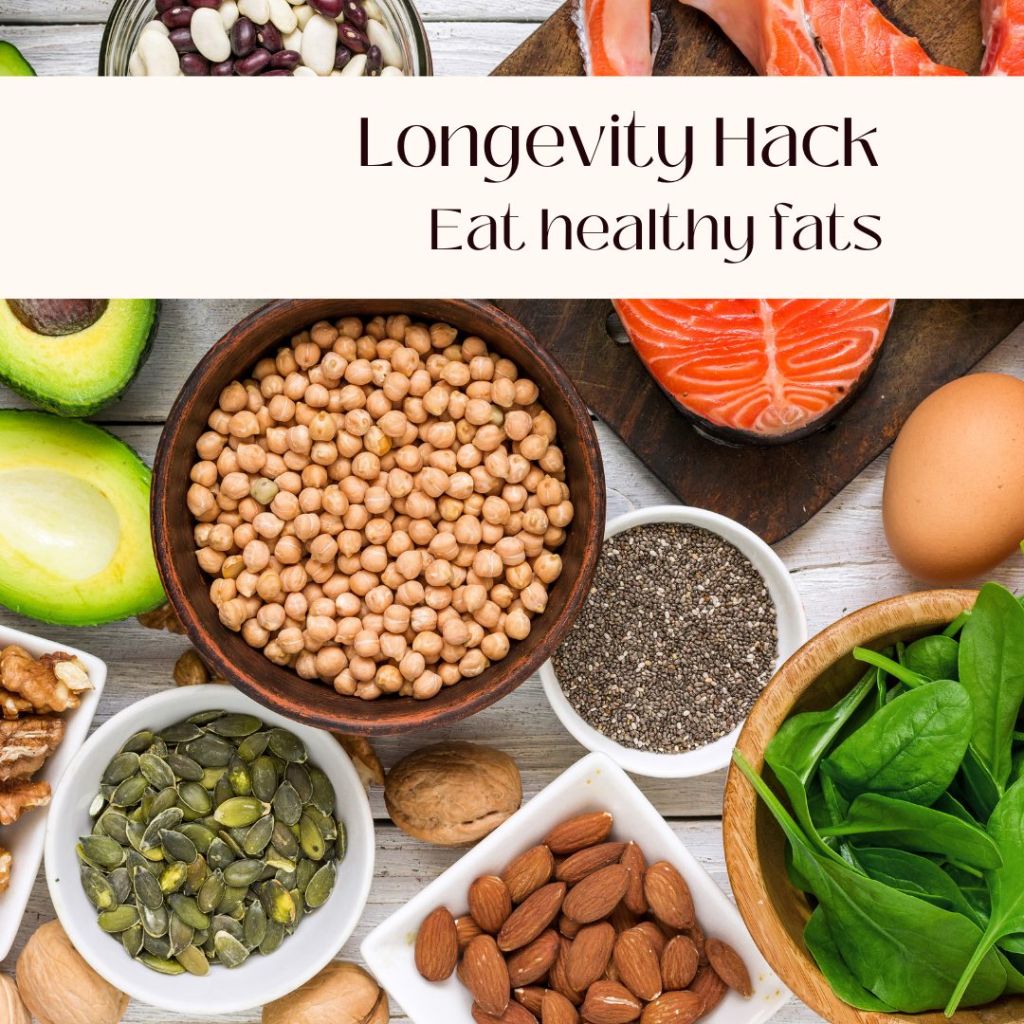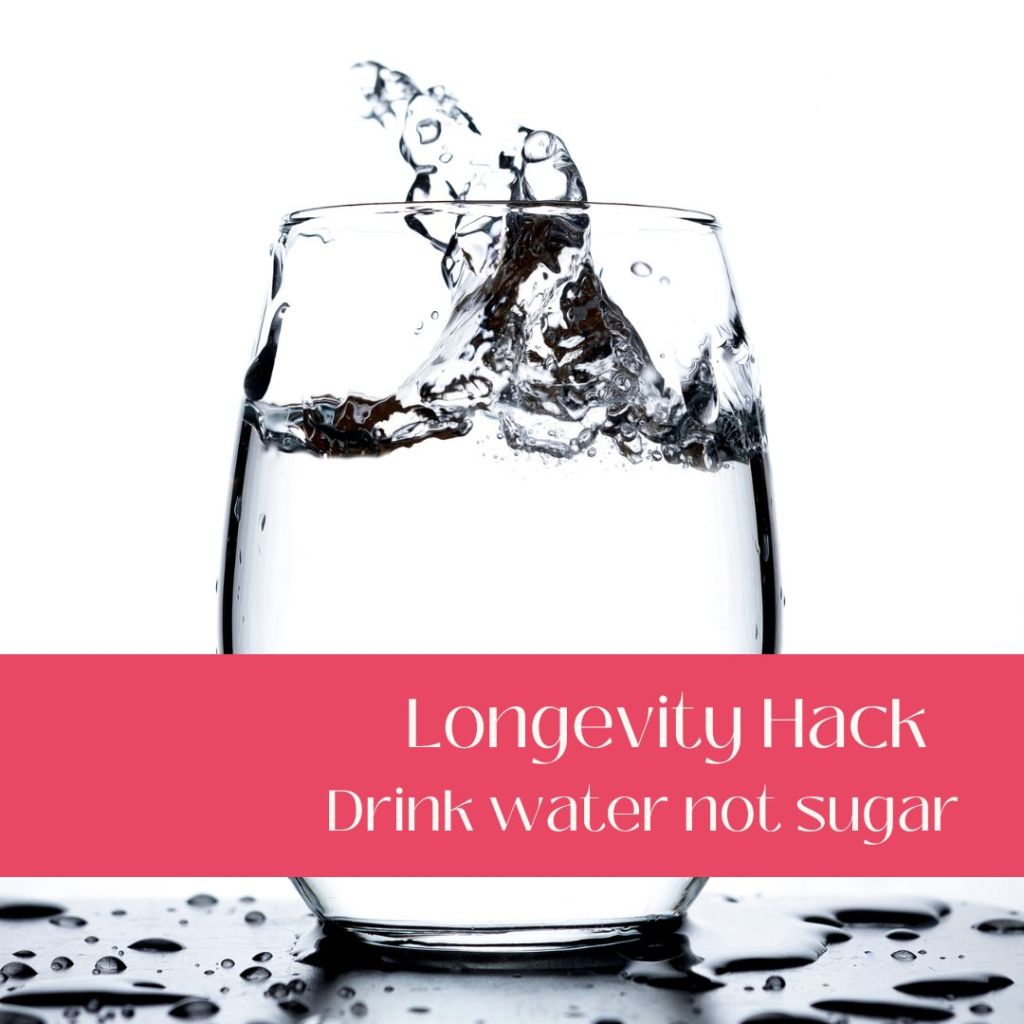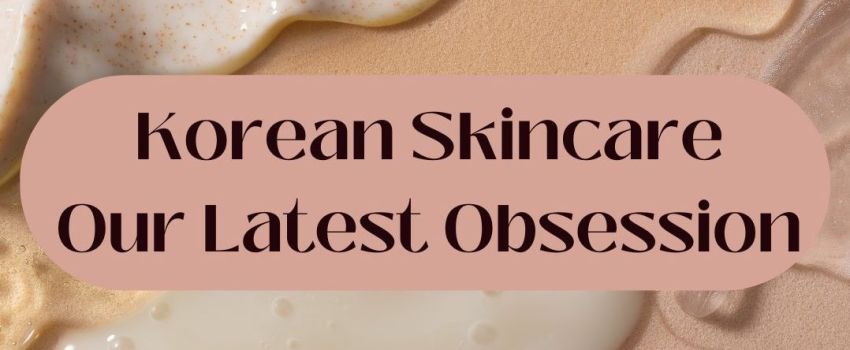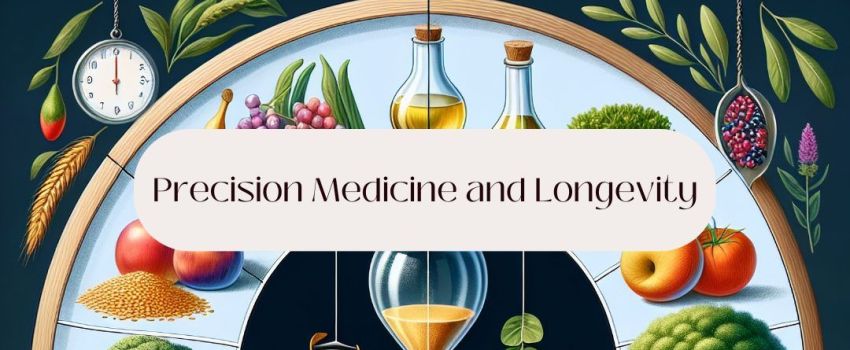We provide complimentary cosmetic treatment consultations with our doctors to discuss any cosmetic enhancement needs.
Sugar & Ageing: The Hidden Link
Poor blood sugar regulation speeds up ageing by increasing inflammation and causing damage to proteins and DNA through glycation. These lead to wrinkles, sagging skin, and diseases like diabetes and dementia.
Stabilising blood sugar through simple diet, exercise, and lifestyle hacks helps slow ageing!
6 simple hacks that help decrease blood sugar spikes:
1. Take a walk or engage in light activity after meals.
Walk 100 steps after each meal, you will live to 99! This Chinese saying highlights the power of simple walking. A 2013 study backed this up: Walking just 15 minutes three times per day after meals effectively helps blood sugar. Stopping sugar spikes is central to longevity.
2. Start your meal with protein- or fibre-filled foods.
Research has shown that the order in which you eat your food impacts how much your blood sugar rises post-meal. Opt for vegetables and protein before simple carbohydrates for a positive effect on blood sugar. For dual benefits, consider incorporating plant-based protein sources like legumes, nuts, and whole grains.
3. Add vinegar to meals to help slow glucose absorption.
Add vinegar to meals to help slow glucose absorption. Vinegar’s main constituent is acetic acid, which gives it its characteristic taste and smell. Consuming vinegar with meals was used as a folk medicine for treating diabetes before pharmacologic glucose-lowering therapy. Studies show that vinegar improves insulin sensitivity in healthy volunteers and individuals with diabetes.
4. Incorporate fat into meals.
Eating healthy fats with carbs can help control blood sugar, as the fats help lower the sugar response to that meal. However, they should be healthy fats (nuts and seeds, avocados, omega-3s from fish and other sources such as flax and chia seeds, and olive oil). Any ultra-processed or trans fat or too much of any fat is counterproductive.
Here are some simple hacks to modify your fat intake to improve your metabolic health:
- Aim to include mostly unprocessed fats in their most natural form
- Limit (or eliminate) your intake of fried foods and processed foods
- Incorporate oily fish a couple of times per week
- Include nuts and seeds regularly in your diet
- If you eat meat (aside from fish), choose lean cuts of meat and trim excess fats
- Practice moderation—too much fat, even health-promoting fat, is counterproductive for the body and longevity!
5. Add cinnamon!
Adding cinnamon to your food to lower blood sugar after meals. Blood sugar levels can increase significantly after eating, leading to oxidative stress and inflammation. Cinnamon helps keep these spikes in check. The mechanism? Research suggests it may slow down the rate at which food empties from your stomach or lower blood sugar by blocking digestive enzymes that break down carbs.
6. Do not drink sugar – opt for water, or tea and coffee in moderation, NOT fruit juice and soda.
Carbohydrates in drinks come in various forms – from added sugars in soft drinks, cordials, and alcoholic beverages to naturally occurring sugars in milk and fruit juice. Swapping one sugary drink serving with water, coffee, or tea can decrease the risk of diabetes, as any sugar-containing drink will raise blood glucose levels. Remember, the choices you make impact your health.
Top performing drinks:
- Water
- Uncarbonated (still) bottled waters, including mineral and spring waters
Runners up:
- Tea and coffee in moderation
- Milk in moderation (choose lower fat varieties if you have high ‘bad’ LDL cholesterol or are trying to reduce your waistline)
- Plain soda water or plain carbonated mineral or spring water in small amounts
- Limited amounts of probiotic drinks for gut health
- Small amounts of home-juiced fruit and veggies (juice the whole fruit to get maximum fiber, without hard skins)
Go easy on:
- Sugar-sweetened drinks, especially carbonated ones
- Fruit juice, sweetened milk drinks/smoothies
- Artificially sweetened drinks
Incorporating these simple hacks into daily practice will maintain stable sugar levels and support healthy longevity.
Ovaries are the ‘canary in the coal mine.’ Studying them could benefit men’s and women’s healthspan!
Reframing the Importance of Studying Reproductive Ageing
By studying ovarian ageing, we can gain insights into overall ageing processes that potentially progress men’s and women’s health: Ovaries age faster than other organs, serving as an early indicator of ageing processes. Studying these early changes could provide critical insights into general ageing mechanisms, which could help men and women progress to living better for longer.
Gaining Insights into Overall Ageing Processes Through Studying Ovarian Ageing
The rapid ageing of the ovaries, compared to other organs, makes them a pivotal marker for studying the broader ageing processes that affect both men and women. Because the ovaries decline functionally at a much earlier age, they provide a unique window into the cellular and molecular pathways that drive ageing across the human body.
Potential for Broader Health Impacts: By studying ovarian ageing, researchers can potentially uncover new ways to mitigate ageing in other ways. The mechanisms behind the decline in ovarian function—such as oxidative stress, telomere shortening, and changes in inflammatory responses—are also common factors in general systemic ageing.
Implications for Men’s and Women’s Health: Although ovarian ageing is specific to women, the general mechanisms of ageing it highlights are applicable to both sexes.
Living Better for Longer: The ultimate goal of studying ovarian ageing is to extend life and improve the quality of life as we age. By identifying how ovary changes correlate with broader health declines, interventions can be designed to maintain health and vigour, regardless of gender.
Promoting Health Equity through Understanding Female Reproductive Ageing
As life expectancy increases and societal norms evolve, more women are choosing to delay childbearing. This shift, coupled with the fact that women live longer, underscores the importance of a deeper understanding of female reproductive ageing. However, extending lifespans without addressing the specific health transitions that women experience, such as menopause, inadvertently widens health disparities.
Enhancing Systemic Health by Understanding Reproductive Ageing
The ageing of ovaries encompasses more than just a decline in fertility; it has profound implications for overall systemic health that extend far beyond the reproduction capability.
- As women age, the quality of their eggs deteriorates, and pregnancies later in life can face increased risks of complications. These direct effects are significant, yet the impact of reproductive ageing spreads even more comprehensively, influencing various other aspects of health.
- Menopause and related conditions represent significant health transitions with a profound negative effect on women’s health. These transitions are not merely about fertility decline but involve systemic physiological changes that can impact long-term health outcomes.
- The incidence of conditions like osteoporosis, cardiovascular disease, arthritis, and changes in brain function such as cognitive decline, insomnia and depression are linked to oestrogen deficiency in women. Other changes include weight gain, increased visceral fat, and profound changes in gut microbiome diversity,
So though modern medicine has achieved remarkable gains in how long women (people) live, going through menopause in midlife means 1/3 of life is spent in an estrogen-deficient state, with accompanying poorer health.
Addressing the unique aspects of female health transitions through dedicated research and tailored healthcare interventions is essential for achieving health equity in our increasingly ageing world.
The Path Forward:
Promoting research into the systemic effects of reproductive ageing can lead to more effective preventive measures, therapies, and health strategies for women and men and an increase in precisely addressing the needs of ageing women. This comprehensive focus could significantly improve quality of life and reduce the burden of age-related diseases, marking a significant step forward in women’s health care.
The Global Consortium for Reproductive Longevity and Equality (GCRLE) is reframing the importance of studying reproductive ageing, effectively marrying the two fields of geroscience and reproductive longevity. The GCRLE’s focus is to catalyse research into reproductive ageing and facilitate an ecosystem that helps accelerate reproductive longevity and equality progress. To bring together scientists, clinicians, and funders, GCRLE seeks to develop interventions to slow or reverse reproductive decline, promoting better health outcomes for women.
The focus on reproductive ageing extends beyond fertility and encompasses a woman’s quality of life, influencing career, family planning, and long-term health. Addressing this with adequate funding and research could lead to significant advancements in gender health equity and quality of life for women as they age.
Why Korean Skincare? K-Beauty is a Force to Be Reckoned With
Korean skincare, part of K-Beauty, is a force to be reckoned with. Korean skincare has gained global recognition for its innovative, gentle, and highly effective approach to beauty, which is affordable and has a fun element with bright packaging and cute names. Here’s why it stands out:
High-Quality Natural Ingredients:
Korean skincare often emphasises natural ingredients, such as Centella Asiatica, snail mucin, and green tea, known for their healing, soothing, and anti-ageing properties. These ingredients provide effective results without harsh chemicals, making them suitable for all skin types, especially sensitive skin.
Innovative Formulations:
Korean beauty brands are at the forefront of skincare innovation, introducing unique products like ampoules, essences, and sleeping masks. Their cutting-edge formulations deliver active ingredients deeply into the skin for maximum benefits.
Holistic Approach:
Korean skincare focuses on prevention and hydration. Its philosophy is that maintaining healthy skin over time is more critical than addressing concerns after they appear. This approach encourages a multi-step routine to nourish, protect, and enhance skin health.
Customisation for Diverse Skin Needs:
Korean skincare offers many targeted solutions for dryness, acne, ageing, and pigmentation. Its emphasis on layering products allows for a customised routine tailored to individual skin concerns.
Affordable Yet Effective:
Despite the high quality of ingredients and innovation, Korean skincare products are often more affordable compared to their Western counterparts, making luxury-level skincare accessible to more people.
Your Organs Age at Different Rates | Precision and Longevity Medicine.
Your organs age at different rates!
A recent study shows that accelerated ageing in just one organ can raise your risk of disease and early death long before symptoms show up. Early detection could be crucial to prevention.
In the up-and-coming longevity and precision medicine field, researchers focus on developing biomarkers that can reveal differential ageing rates. It has become clear that your organs age at different rates, and being able to measure this can potentially predict the risk of disease and mortality well before clinical symptoms even appear.
A critical study conducted by Stanford Medicine, involving 5,678 participants, underscored this by identifying that one in five adults over 50 has at least one organ ageing at an accelerated rate. This misalignment between an organ’s biological age and the person’s chronological age amplifies the risk of organ-specific diseases and mortality.
Blood Tests Of the Future
Utilising blood tests, the researchers measured nearly 5,000 proteins to ascertain organ-specific markers that help determine the biological age of critical organs such as the heart, brain, lungs, and kidneys. Findings revealed that accelerated ageing in any one organ could significantly increase susceptibility to diseases like heart failure, cognitive decline, and Alzheimer’s disease.
The promise of a simple blood test could revolutionise how we monitor health in ostensibly healthy individuals, allowing for the early implementation of targeted therapeutic interventions. This proactive approach aims to extend life and enhance the quality of life, paving the way for advancements in drug development and personalised healthcare strategies. This study highlights the critical role of precision medicine in intercepting and altering the course of ageing, reinforcing the necessity for further research into reliable biomarkers that guide effective longevity treatments.
Ageing Biomarkers, Precision Medicine and Longevity: The New Frontier
Precision medicine is revolutionising healthcare by offering a personalised approach that considers an individual’s genetic makeup, environment, and lifestyle. Unlike traditional medicine, which provides a one-size-fits-all approach, precision medicine tailors treatments to the unique characteristics of each patient. While this has already made waves in fields like cancer treatment and pharmacogenomics, it is now paving the way for longevity medicine. This field focuses on extending health plans and delaying the onset of age-related diseases.
Interestingly, while genomics plays a critical role in precision medicine, research shows that genetics account for only about 10% of how we age. Environmental factors and lifestyle choices, such as diet, physical activity, stress levels, and sleep patterns, influence the other 90%.
Biomarkers: The Key to Unlocking Ageing
At the heart of longevity medicine is the search for accurate biomarkers of aging—measurable indicators that help assess biological age rather than chronological age. Biomarkers are essential for identifying early signs of ageing at the cellular level, allowing for interventions long before age-related diseases appear.
Biomarkers come in various forms and can include:
- Ageing clocks, such as DNA methylation and glycation, offer insights into the biological processes of ageing.
- Blood biomarkers like cholesterol and blood sugar levels reflect metabolic health.
- Omics testing (including genomics, proteomics, and metabolomics) provides a more comprehensive understanding of cellular ageing.
- Physical tests, such as VO2 max (oxygen capacity), grip strength, and gait speed, are reliable markers of physical ageing.
- Gut microbiome testing to determine species and diversity of intestinal bacteria
The critical challenge is identifying accurate biomarkers and understanding their significance and how they respond to interventions. Once these are established, we can implement strategies to slow ageing processes and continuously monitor progress through retesting.
The Revolution in Longevity Medicine Interventions
With biomarkers in hand, longevity medicine focuses on interventions designed to delay ageing. The precision of these interventions depends on the ability to measure and track changes accurately over time. Currently, longevity interventions are based on five pillars:
1. Diet: We already have a solid understanding of the impact of diet on healthy ageing, with recommendations favouring predominantly plant-based whole foods. Timing is also crucial, with approaches like time-restricted eating and intermittent fasting showing benefits. However, precision medicine will take this even further by personalising dietary choices. For example, genetic testing can reveal if someone is a hyper-absorber of cholesterol, allowing them to make informed choices, such as limiting cholesterol-rich foods like eggs, to support their health and longevity better
2. Exercise: While general recommendations include 30 minutes of daily activity and strength training 2-3 times a week, the future of precision medicine could prescribe personalised exercise regimens based on biomarkers, ensuring individuals engage in the types and intensity of exercise that will optimise their longevity.
3. Stress Management and Sleep: Reducing stress and improving sleep quality is crucial for longevity. Biomarkers such as cortisol levels and heart rate variability can track the body’s response to stress and sleep patterns, allowing for targeted interventions that promote recovery and resilience.
4. Social Connections and Purpose: Maintaining solid social ties and having a clear sense of purpose are vital to healthy ageing. Longevity medicine is increasingly placing emphasis on mental and emotional health, recognising the critical role that psychosocial factors play in the ageing process. A growing area of research, known as psycho-ageing, sheds light on how our thoughts and attitudes about ageing can influence how we age. Understanding and promoting positive perceptions of ageing can improve mental and physical health as we grow older.
5. Drugs and Supplements: While there is ongoing research into pharmaceutical options like rapamycin and metformin, as well as supplements such as NMN and Urolithin A, the field has not yet reached a stage where universal recommendations can be made. As biomarker data becomes more precise, interventions will become more effectively targeted. Although we have a solid understanding of the hallmarks of cellular ageing, the key is identifying suitable biomarkers to provide precise interventions. Just like you wouldn’t take vitamin B12 for a vitamin D deficiency, it’s essential that any treatment directly addresses the specific ageing mechanism identified through biomarker testing
The Future of Longevity Medicine: An Evidence-Based Approach
Longevity medicine is at the cutting edge of healthcare, offering a science-based, evidence-driven approach to ageing. The identification and application of ageing biomarkers are essential for this field to evolve, as they allow clinicians to measure the effectiveness of interventions and adjust them accordingly. This iterative process of testing, intervening, and retesting should ultimately make longevity medicine successful in extending both lifespan and health span.
An upcoming conference held by the Biomarkers of Ageing Consortium in Boston on November 1st, 2024, highlights how quickly this field advances as researchers gather to share insights and breakthroughs. With the pace of research accelerating, the future of longevity medicine promises to provide practical, personalised strategies to combat ageing, enabling people to live longer, healthier lives.
Precision medicine is unlocking the key to healthy aging! 🧬 By identifying accurate biomarkers, we can target ageing processes earlier, offering personalised interventions that help extend health span and prevent age-related diseases. The future of longevity is tailored to YOU!
Denying women HRT is like slamming the door shut on their career, health, and sanity!
Women, wellness, and work.
Women over 50 are one of the fastest-growing groups in the workforce, but menopausal symptoms can significantly affect their quality of life, work performance, and attendance. Despite this, the specific impacts of menopause on work and career development have been understudied. Symptoms like fatigue, difficulty sleeping, poor concentration, and memory issues frequently impact work and are linked to reduced performance, attendance, and career progression decisions.
Mood and menopause.
Mood changes during perimenopause and menopause are due primarily to fluctuating hormone levels, particularly oestrogen. Hormone replacement therapy (HRT), which stabilises these hormone levels by giving replacement oestrogen and, for some women, testosterone, is one of the most effective treatments.
The correct dose and type of HRT can significantly improve mood, restoring motivation, energy, and a sense of well-being. Many women report feeling calmer and happier within a few months of starting HRT, alongside improvements in other menopausal symptoms like hot flashes, night sweats, insomnia, and vaginal dryness.
Research also suggests that starting HRT during perimenopause can lower the risk of developing clinical depression. Women who have previously been prescribed antidepressants often find that their mood improves with the suitable HRT, enabling them to reduce or even stop their antidepressants as their symptoms improve.
Health risks and oestrogen decline.
Postmenopausal women face a range of health challenges, to name a few: increased risks of cardiovascular disease, osteoporosis, and dementia.
Cardiovascular Disease: After menopause, women’s risk of heart disease rises significantly. The loss of oestrogen, which has protective effects on blood vessels, can lead to higher blood pressure and cholesterol and an increased risk of heart attacks and strokes. Studies show that women experience a notable rise in cardiovascular risk factors after menopause, contributing to their higher risk compared to pregnant women.
Osteoporosis: Postmenopausal osteoporosis is common, affecting about 1 in 3 women worldwide. Oestrogen deficiency accelerates bone loss, making women more susceptible to fractures. Around 50% of women over 50 may experience a bone fracture due to osteoporosis(
Dementia: There is growing evidence linking menopause-related changes, particularly in hormones, to an increased risk of cognitive decline and dementia. Oestrogen appears to have a protective role in brain health, and its decline during menopause may contribute to a higher risk of dementia later in life.
Menopause is a Superpower – The Grandmother Hypothesis
What do humans and orcas have in common?
Beyond being mammals, we share an astonishing evolutionary trait: We are part of a rare club that experiences menopause. Others in our group include narwhals, belugas, and short-finned pilot whales.
Why do such vastly different creatures share this trait?
We do not know, however; research suggests menopause evolved to boost species survival and longevity, allowing older females to support future generations. This is called the grandmother hypothesis.
Orca Social Structure
Orcas live in matriarchal pods, where male and female offspring remain with the group throughout their lives. Grandmother orcas provide intergenerational support for their grand-calves, boosting the entire pod’s survival and ultimately helping future generations.
- Menopausal whales live decades longer, seeing their grandchildren mature, whereas non-menopausal whales die much earlier.
- This extended life doesn’t apply to males, who prioritise mating with multiple partners over family care.
- Adult male orcas are more likely to survive when their mothers are present.
This parallel evolution in humans and toothed whales reveals how menopause evolved to boost intergenerational support and survival. Perhaps menopause is a superpower in improving the security of our species.
Climacteric Sanity and The Wandering Womb
The common use of antidepressants over HRT ignores the crucial impact of hormonal changes on women’s mental health during perimenopause.
There is a persistent trend of prescribing antidepressants rather than hormone replacement therapy (HRT) for menopause symptoms like depression and anxiety.
The symptoms arise because oestrogen levels drop quickly during the transition period of perimenopause. The brain (like just about every cell in the human body) contains oestrogen receptors. So as oestrogen plummets, a rollercoaster ride of emotion is unleashed.
Prescription of antidepressants for these symptoms raises essential questions about knowledge and gender biases in medicine.
Have historical misconceptions surrounding menopause influenced treatment approaches?
In the Victorian era, the term “climacteric insanity” encapsulated the view of menopause as a form of mental illness, leading to radical cures like oophorectomy or institutionalisation. This period was characterised by a profound misunderstanding of female health and reflected broader societal stigmas regarding the direct connection between women’s reproductive health and mental stability.
Moving back further to the Middle Ages, the notion of a “wandering womb” causing physical and psychological ailments further illustrates how archaic and misguided perspectives have plagued women’s healthcare. So, how far have we come?
Today, despite a significant shift in understanding, there remains a notable reliance on antidepressants to treat symptoms more directly associated with hormonal changes rather than addressing the root cause through HRT.
This approach overlooks substantial evidence that HRT is more effective in not only stabilising hormone levels but also in alleviating the full spectrum of menopausal symptoms, including mood disturbances.
Organisations like The Menopause Charity and a growing chorus of doctors working in the menoverse advocate for HRT as the first-line treatment, emphasising its benefits over antidepressants..
The prevalent issue of antidepressants being overprescribed to perimenopausal women can be attributed to a multifaceted set of challenges within the healthcare system.
A critical factor is the inadequate training that healthcare providers receive regarding the nuances of perimenopause and menopause and the effective use of hormone replacement therapy (HRT). This educational gap, combined with insufficient funding dedicated to women’s health research, perpetuates outdated treatment approaches.
Moreover, societal and medical ignorance surrounding menopause lingers. We are still trying to escape the long shadow cast over menopause management that arose from misinterpretations of the Women’s Health Initiative. Additionally, there is an inherent gender bias in medical treatment; psychological symptoms in women are perhaps too readily diagnosed as mental health issues without investigation into possible hormonal or physiological origins.
More broadly, social views of aging, particularly in women, make this oversight worse. The role of the grandmother is precious, but women become silent and silenced, and the health concerns of women of ‘a certain age’ are minimised. Menopause is hot flashes, right? This reductionist view overlooks the broader spectrum of menopausal impacts and fails to address the role and needs of ageing women comprehensively.
Addressing these issues requires a concerted effort to enhance medical education, increase funding for women’s health research, and shift societal attitudes to recognise and adequately treat health conditions unique to women during menopause.
The historical trajectory from viewing menopause as a disease to a life stage progresses, yet the current prescribing practices suggest that more strides are needed to transcend outdated notions and provide care that aligns with contemporary medical understanding.
It is crucial to challenge these persistent gaps in understanding and bias and ensure that treatment options are rooted in the best available science, advocating for patient-centred care that genuinely addresses the complexities of women’s health during menopause.


